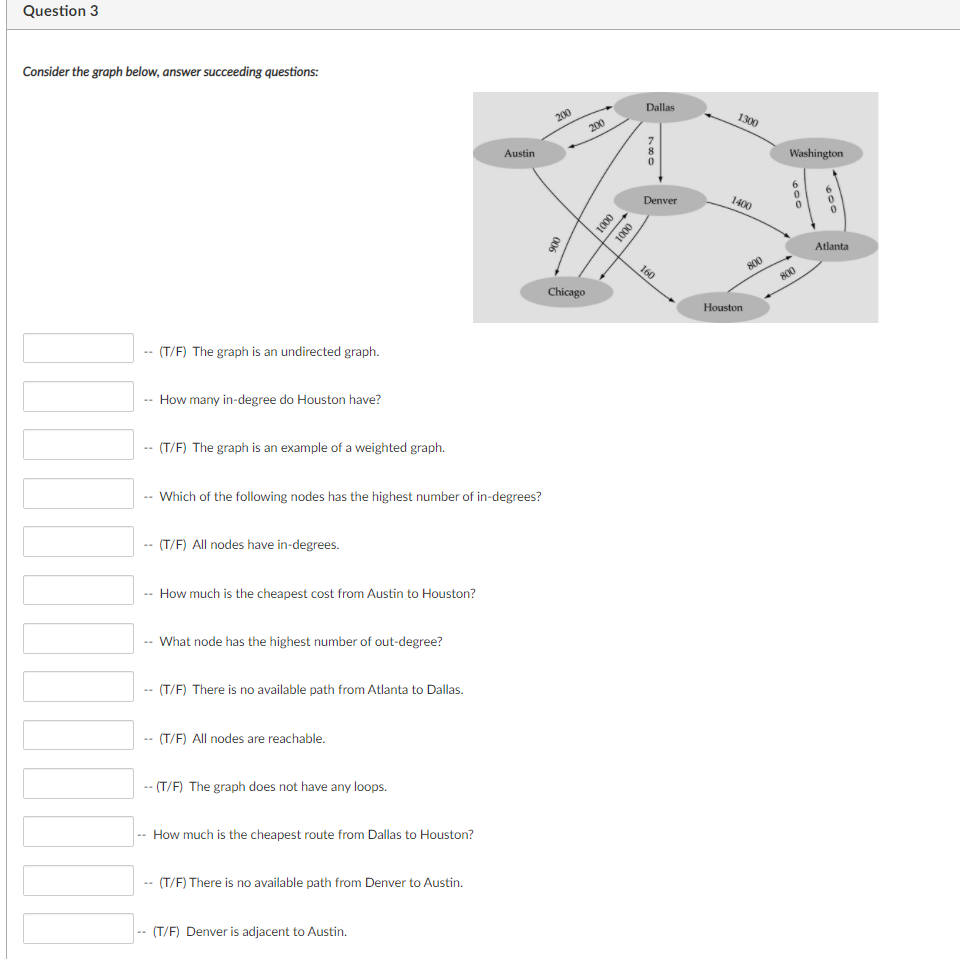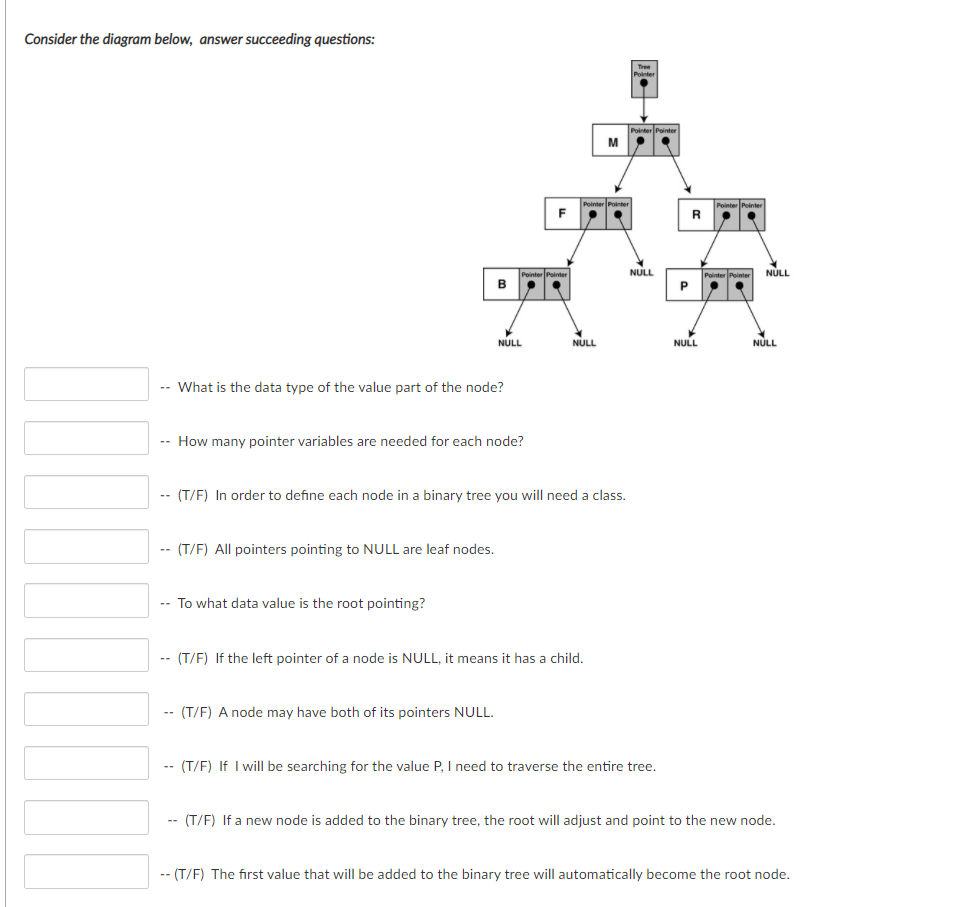Consider the graph below, answer succeeding questions: Dallas 200 1300 200 Austin Washington Denver 1400 Atlanta 160 800 800 Chicago Houston -- (T/F) The graph is an undirected graph. -- How many in-degree do Houston have? -- (T/F) The graph is an example of a weighted graph. - Which of the following nodes has the highest number of in-degrees? -- (T/F) All nodes have in-degrees. -- How much is the cheapest cost from Austin to Houston? -- What node has the highest number of out-degree? -- (T/F) There is no available path from Atlanta to Dallas. -- (T/F) All nodes are reachable. -- (T/F) The graph does not have any loops. How much is the cheapest route from Dallas to Houston? -- (T/F) There is no available path from Denver to Austin. - (T/F) Denver is adjacent to Austin. 430 400 0001 0001 006
Consider the graph below, answer succeeding questions: Dallas 200 1300 200 Austin Washington Denver 1400 Atlanta 160 800 800 Chicago Houston -- (T/F) The graph is an undirected graph. -- How many in-degree do Houston have? -- (T/F) The graph is an example of a weighted graph. - Which of the following nodes has the highest number of in-degrees? -- (T/F) All nodes have in-degrees. -- How much is the cheapest cost from Austin to Houston? -- What node has the highest number of out-degree? -- (T/F) There is no available path from Atlanta to Dallas. -- (T/F) All nodes are reachable. -- (T/F) The graph does not have any loops. How much is the cheapest route from Dallas to Houston? -- (T/F) There is no available path from Denver to Austin. - (T/F) Denver is adjacent to Austin. 430 400 0001 0001 006
Computer Networking: A Top-Down Approach (7th Edition)
7th Edition
ISBN:9780133594140
Author:James Kurose, Keith Ross
Publisher:James Kurose, Keith Ross
Chapter1: Computer Networks And The Internet
Section: Chapter Questions
Problem R1RQ: What is the difference between a host and an end system? List several different types of end...
Related questions
Question
Help me with these TWO problems: DATA & STRUCTURES

Transcribed Image Text:Question 3
Consider the graph below, answer succeeding questions:
Dallas
200
1300
200
Austin
Washington
Denver
1400
Atlanta
160
800
800
Chicago
Houston
- (T/F) The graph is an undirected graph.
How many in-degree do Houston have?
- (T/F) The graph is an example of a weighted graph.
Which of the following nodes has the highest number of in-degrees?
(T/F) All nodes have in-degrees.
How much is the cheapest cost from Austin to Houston?
What node has the highest number of out-degree?
(T/F) There is no available path from Atlanta to Dallas.
- (T/F) All nodes are reachable.
-- (T/F) The graph does not have any loops.
How much is the cheapest route from Dallas to Houston?
--
(T/F) There is no available path from Denver to Austin.
(T/F) Denver is adjacent to Austin.
600
490
80
0001
0001
006

Transcribed Image Text:Consider the diagram below, answer succeeding questions:
Tree
Pointer Pointe
M
Pointer Polnter
F
Pointer Peiote
R
ointer Pointer
NULL
Pointer Peinter
NULL
NULL
NULL
NULL
NULL
-- What is the data type of the value part of the node?
-- How many pointer variables are needed for each node?
-- (T/F) In order to define each node in a binary tree you will need a class.
-- (T/F) All pointers pointing to NULL are leaf nodes.
-- To what data value is the root pointing?
-- (T/F) If the left pointer of a node is NULL, it means it has a child.
-- (T/F) A node may have both of its pointers NULL.
-- (T/F) If I will be searching for the value P, I need to traverse the entire tree.
-- (T/F) If a new node is added to the binary tree, the root will adjust and point to the new node.
-- (T/F) The first value that will be added to the binary tree will automatically become the root node.
Expert Solution
This question has been solved!
Explore an expertly crafted, step-by-step solution for a thorough understanding of key concepts.
This is a popular solution!
Trending now
This is a popular solution!
Step by step
Solved in 3 steps with 1 images

Recommended textbooks for you

Computer Networking: A Top-Down Approach (7th Edi…
Computer Engineering
ISBN:
9780133594140
Author:
James Kurose, Keith Ross
Publisher:
PEARSON

Computer Organization and Design MIPS Edition, Fi…
Computer Engineering
ISBN:
9780124077263
Author:
David A. Patterson, John L. Hennessy
Publisher:
Elsevier Science

Network+ Guide to Networks (MindTap Course List)
Computer Engineering
ISBN:
9781337569330
Author:
Jill West, Tamara Dean, Jean Andrews
Publisher:
Cengage Learning

Computer Networking: A Top-Down Approach (7th Edi…
Computer Engineering
ISBN:
9780133594140
Author:
James Kurose, Keith Ross
Publisher:
PEARSON

Computer Organization and Design MIPS Edition, Fi…
Computer Engineering
ISBN:
9780124077263
Author:
David A. Patterson, John L. Hennessy
Publisher:
Elsevier Science

Network+ Guide to Networks (MindTap Course List)
Computer Engineering
ISBN:
9781337569330
Author:
Jill West, Tamara Dean, Jean Andrews
Publisher:
Cengage Learning

Concepts of Database Management
Computer Engineering
ISBN:
9781337093422
Author:
Joy L. Starks, Philip J. Pratt, Mary Z. Last
Publisher:
Cengage Learning

Prelude to Programming
Computer Engineering
ISBN:
9780133750423
Author:
VENIT, Stewart
Publisher:
Pearson Education

Sc Business Data Communications and Networking, T…
Computer Engineering
ISBN:
9781119368830
Author:
FITZGERALD
Publisher:
WILEY